[English] 日本語
 Yorodumi
Yorodumi- PDB-4fh0: Crystal Structure of Human BinCARD CARD, double mutant F16M/L66M ... -
+ Open data
Open data
- Basic information
Basic information
| Entry | Database: PDB / ID: 4fh0 | ||||||
|---|---|---|---|---|---|---|---|
| Title | Crystal Structure of Human BinCARD CARD, double mutant F16M/L66M SeMet form | ||||||
 Components Components | Bcl10-interacting CARD protein | ||||||
 Keywords Keywords | IMMUNE SYSTEM / Apoptosis / Mainly alpha / Bcl10 / Nucleus / ER / Mitochondria | ||||||
| Function / homology |  Function and homology information Function and homology informationCARD domain binding / negative regulation of canonical NF-kappaB signal transduction / mitochondrial membrane / endoplasmic reticulum membrane / mitochondrion / nucleus / cytosol Similarity search - Function | ||||||
| Biological species |  Homo sapiens (human) Homo sapiens (human) | ||||||
| Method |  X-RAY DIFFRACTION / X-RAY DIFFRACTION /  SYNCHROTRON / SYNCHROTRON /  MAD / Resolution: 1.4 Å MAD / Resolution: 1.4 Å | ||||||
 Authors Authors | Chen, K.-E. / Kobe, B. / Martin, J.L. | ||||||
 Citation Citation |  Journal: Acta Crystallogr.,Sect.D / Year: 2013 Journal: Acta Crystallogr.,Sect.D / Year: 2013Title: The structure of the caspase recruitment domain of BinCARD reveals that all three cysteines can be oxidized. Authors: Chen, K.E. / Richards, A.A. / Caradoc-Davies, T.T. / Vajjhala, P.R. / Robin, G. / Lua, L.H. / Hill, J.M. / Schroder, K. / Sweet, M.J. / Kellie, S. / Kobe, B. / Martin, J. | ||||||
| History |
|
- Structure visualization
Structure visualization
| Structure viewer | Molecule:  Molmil Molmil Jmol/JSmol Jmol/JSmol |
|---|
- Downloads & links
Downloads & links
- Download
Download
| PDBx/mmCIF format |  4fh0.cif.gz 4fh0.cif.gz | 136.8 KB | Display |  PDBx/mmCIF format PDBx/mmCIF format |
|---|---|---|---|---|
| PDB format |  pdb4fh0.ent.gz pdb4fh0.ent.gz | 110.4 KB | Display |  PDB format PDB format |
| PDBx/mmJSON format |  4fh0.json.gz 4fh0.json.gz | Tree view |  PDBx/mmJSON format PDBx/mmJSON format | |
| Others |  Other downloads Other downloads |
-Validation report
| Summary document |  4fh0_validation.pdf.gz 4fh0_validation.pdf.gz | 442.8 KB | Display |  wwPDB validaton report wwPDB validaton report |
|---|---|---|---|---|
| Full document |  4fh0_full_validation.pdf.gz 4fh0_full_validation.pdf.gz | 443.5 KB | Display | |
| Data in XML |  4fh0_validation.xml.gz 4fh0_validation.xml.gz | 13.5 KB | Display | |
| Data in CIF |  4fh0_validation.cif.gz 4fh0_validation.cif.gz | 18.3 KB | Display | |
| Arichive directory |  https://data.pdbj.org/pub/pdb/validation_reports/fh/4fh0 https://data.pdbj.org/pub/pdb/validation_reports/fh/4fh0 ftp://data.pdbj.org/pub/pdb/validation_reports/fh/4fh0 ftp://data.pdbj.org/pub/pdb/validation_reports/fh/4fh0 | HTTPS FTP |
-Related structure data
- Links
Links
- Assembly
Assembly
| Deposited unit | 
| ||||||||
|---|---|---|---|---|---|---|---|---|---|
| 1 | 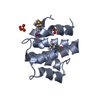
| ||||||||
| 2 | 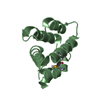
| ||||||||
| Unit cell |
| ||||||||
| Details | The biological unit is a monomer. There is 2 biological unit in the asymmetric unit |
- Components
Components
| #1: Protein | Mass: 12135.491 Da / Num. of mol.: 2 / Fragment: caspase recruitment domain / Mutation: F16M, L66M Source method: isolated from a genetically manipulated source Source: (gene. exp.)  Homo sapiens (human) / Gene: C9orf89 / Plasmid: pMCSG7 / Production host: Homo sapiens (human) / Gene: C9orf89 / Plasmid: pMCSG7 / Production host:  #2: Chemical | #3: Water | ChemComp-HOH / | Has protein modification | Y | |
|---|
-Experimental details
-Experiment
| Experiment | Method:  X-RAY DIFFRACTION / Number of used crystals: 1 X-RAY DIFFRACTION / Number of used crystals: 1 |
|---|
- Sample preparation
Sample preparation
| Crystal | Density Matthews: 1.94 Å3/Da / Density % sol: 36.21 % |
|---|---|
| Crystal grow | Temperature: 298 K / Method: vapor diffusion / pH: 6.5 Details: Bis-Tris pH 6.5, ammonium sulfate, PEG 3350, VAPOR DIFFUSION, temperature 298K |
-Data collection
| Diffraction | Mean temperature: 100 K | ||||||||||||
|---|---|---|---|---|---|---|---|---|---|---|---|---|---|
| Diffraction source | Source:  SYNCHROTRON / Site: SYNCHROTRON / Site:  Australian Synchrotron Australian Synchrotron  / Beamline: MX2 / Wavelength: 0.9537, 0.9797, 0.9795 / Beamline: MX2 / Wavelength: 0.9537, 0.9797, 0.9795 | ||||||||||||
| Detector | Type: ADSC QUANTUM 315r / Detector: CCD / Date: Jul 9, 2009 | ||||||||||||
| Radiation | Monochromator: Sagitally focused Si / Protocol: MAD / Monochromatic (M) / Laue (L): M / Scattering type: x-ray | ||||||||||||
| Radiation wavelength |
| ||||||||||||
| Reflection | Resolution: 1.25→32.139 Å / Num. all: 45786 / Num. obs: 45785 / % possible obs: 99.9 % / Observed criterion σ(F): 0 / Observed criterion σ(I): 0 / Redundancy: 7.1 % / Biso Wilson estimate: 12 Å2 / Limit h max: 25 / Limit h min: -25 / Limit k max: 27 / Limit k min: -29 / Limit l max: 34 / Limit l min: 0 / Rmerge(I) obs: 0.08 / Net I/σ(I): 16.2 | ||||||||||||
| Reflection scale | Group code: 1 | ||||||||||||
| Reflection shell | Resolution: 1.4→1.47 Å / Redundancy: 7 % / Rmerge(I) obs: 0.58 / Mean I/σ(I) obs: 4.4 / Num. unique all: 6572 / % possible all: 92.4 |
-Phasing
| Phasing | Method:  MAD MAD |
|---|
- Processing
Processing
| Software |
| |||||||||||||||||||||||||||||||||||||||||||||||||||||||||||||||||||||||||||||||||||||||||||
|---|---|---|---|---|---|---|---|---|---|---|---|---|---|---|---|---|---|---|---|---|---|---|---|---|---|---|---|---|---|---|---|---|---|---|---|---|---|---|---|---|---|---|---|---|---|---|---|---|---|---|---|---|---|---|---|---|---|---|---|---|---|---|---|---|---|---|---|---|---|---|---|---|---|---|---|---|---|---|---|---|---|---|---|---|---|---|---|---|---|---|---|---|
| Refinement | Method to determine structure:  MAD / Resolution: 1.4→27.724 Å / Occupancy max: 1 / Occupancy min: 0 / FOM work R set: 0.9167 / SU ML: 0.27 / σ(F): 2.44 / Phase error: 15.79 / Stereochemistry target values: ML MAD / Resolution: 1.4→27.724 Å / Occupancy max: 1 / Occupancy min: 0 / FOM work R set: 0.9167 / SU ML: 0.27 / σ(F): 2.44 / Phase error: 15.79 / Stereochemistry target values: ML
| |||||||||||||||||||||||||||||||||||||||||||||||||||||||||||||||||||||||||||||||||||||||||||
| Solvent computation | Shrinkage radii: 0.86 Å / VDW probe radii: 1.1 Å / Solvent model: FLAT BULK SOLVENT MODEL / Bsol: 60.123 Å2 / ksol: 0.4 e/Å3 | |||||||||||||||||||||||||||||||||||||||||||||||||||||||||||||||||||||||||||||||||||||||||||
| Displacement parameters | Biso max: 49.37 Å2 / Biso mean: 17.6784 Å2 / Biso min: 6.2 Å2
| |||||||||||||||||||||||||||||||||||||||||||||||||||||||||||||||||||||||||||||||||||||||||||
| Refine analyze | Luzzati coordinate error obs: 0.27 Å | |||||||||||||||||||||||||||||||||||||||||||||||||||||||||||||||||||||||||||||||||||||||||||
| Refinement step | Cycle: LAST / Resolution: 1.4→27.724 Å
| |||||||||||||||||||||||||||||||||||||||||||||||||||||||||||||||||||||||||||||||||||||||||||
| Refine LS restraints |
| |||||||||||||||||||||||||||||||||||||||||||||||||||||||||||||||||||||||||||||||||||||||||||
| LS refinement shell | Refine-ID: X-RAY DIFFRACTION / Total num. of bins used: 12
|
 Movie
Movie Controller
Controller


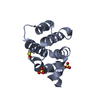

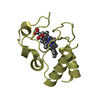

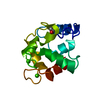
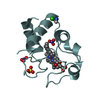
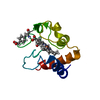
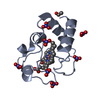

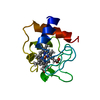

 PDBj
PDBj







